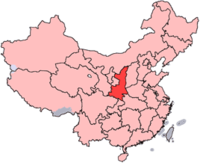

Qinqiang (秦腔, pinyin: Qín qiāng, literally "Qin's tune"[1]) is a genre of folk Chinese opera originated in Shaanxi Province of Qing China in 1807 and soon took over other genres to be the representative genre of the province.[2] Historically, there were two separate genres both referring themselves as Qinqiang, the one with a longer history was later renamed as Handiao Erhuang (汉调二簧),[2] while the newer genre is the topic of this article.
The genre features bangzi (wooden clapper) as its accompanying instruments, from which it derives its other names, Bangzi opera and luàntán (亂彈, literally "hit in chaos"). Bangzi tune is considered one of China's Four Great Characteristic Melodies. Qinqiang is the representative of the Bangzi opera and the most important origin of other Bangzi operas.[3][4] It plays a key role in Chinese traditional culture as its birth and development process is the result of the development of Chinese local opera since ancient times.[5]
- ^ Yuet Chau, Adam (2006). Miraculous response: doing popular religion in contemporary China. Stanford University Press. p. 53. ISBN 9780804767651. Retrieved November 17, 2010.
- ^ a b Cite error: The named reference
Guo 2007was invoked but never defined (see the help page). - ^ Women of China. 2001. Retrieved November 17, 2010.
- ^ "Chinese opera The First Emperor transmitted live into theaters worldwide". People's Daily. January 14, 2007. Retrieved November 17, 2010.
- ^ "国家哲学社会科学文献中心". www.ncpssd.org. Retrieved 2019-07-16.
© MMXXIII Rich X Search. We shall prevail. All rights reserved. Rich X Search
